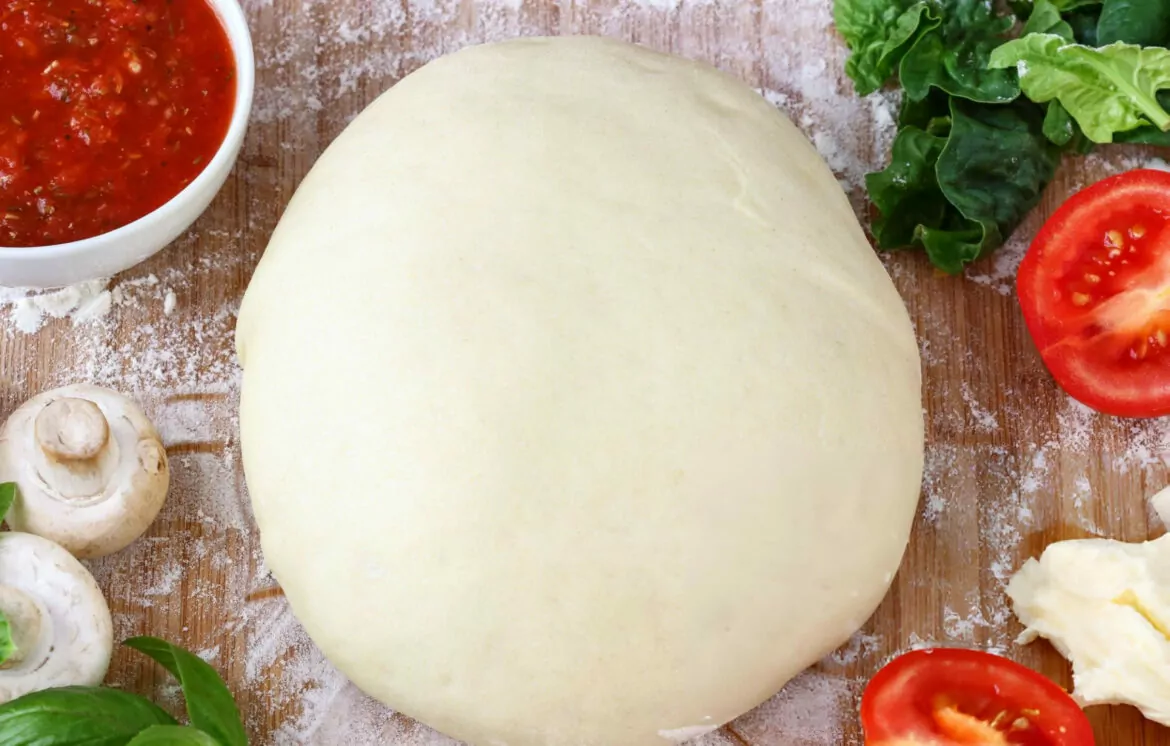A pizza’s success is deeply rooted in its dough. The crust is the very foundation that carries all the flavors, textures, and toppings that make pizza a universal favorite. Without a solid base, even the most exquisite toppings can falter. This recipe offers a simple yet foolproof way to create that perfect dough at home, ensuring your pizza is nothing short of extraordinary. The balance of ingredients and precise techniques used here makes this recipe stand out, offering a crisp yet chewy crust that’s sure to impress. If you’ve never tried making pizza dough from scratch, this is your sign to dive in—you’ll never go back to store-bought again.
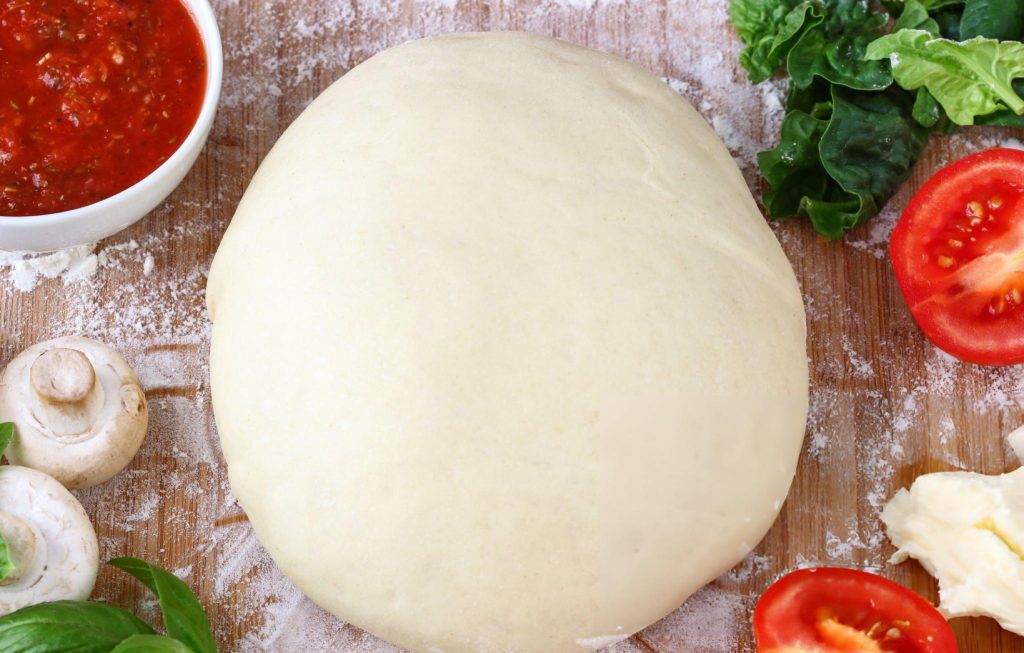
Ingredients Breakdown: What You’ll Need
This pizza dough recipe calls for a few simple ingredients, each playing a crucial role in the final product. The 1 ½ teaspoons of sugar not only adds a touch of sweetness but also feeds the yeast, helping the dough rise to perfection. Salt, in a precise ¾ teaspoon measure, enhances the flavor of the dough and controls yeast activity, ensuring a steady rise. Warm water at 175ml is the perfect medium to activate the yeast, while the 2 ¼ teaspoons of instant yeast provide the necessary lift. Olive oil, with its smooth, rich flavor, adds moisture and contributes to the dough’s elasticity.
For the flour, you have the option between all-purpose and bread flour. All-purpose flour offers a softer, more tender crust, while bread flour, with its higher gluten content, results in a chewier, more robust base. If you wish to add a bit of flair, ⅛ to ¼ teaspoon of garlic powder and/or dried basil can be mixed in, subtly infusing the dough with extra flavor. This optional step can elevate your dough from basic to gourmet, adding a layer of complexity to your pizza’s foundation.
Step-by-Step Instructions: Crafting Your Dough
The first step in this process is mixing the dough. Begin by combining 1 cup of flour with the yeast, sugar, and salt in a large bowl. If you’re opting to add garlic powder or dried basil, now is the perfect time to do so. These ingredients should be thoroughly mixed before adding the olive oil and warm water. Stir vigorously with a wooden spoon until the mixture is fully combined and smooth.
As you move on to kneading and shaping the dough, gradually add another cup of flour to the mix. This step is crucial—add just enough flour until the dough forms a cohesive ball. It should pull away from the sides of the bowl but still retain a slightly sticky texture. This balance ensures that your dough is elastic and easy to work with.
Once your dough is formed, it’s time to let it rise. Find a warm, draft-free spot in your kitchen—this is key to a successful rise. Cover the dough tightly with plastic wrap and allow it to rest for about 30 minutes, or until it has doubled in size. The waiting period is worth it; this rise will give your crust the light, airy texture that defines a great pizza.
After the dough has risen, gently deflate it and transfer it to a lightly floured surface. Knead it briefly until smooth, then shape it into a 12-inch circle. This step is where you can decide the thickness of your crust. Roll it thinner for a crispy base or leave it slightly thicker for a chewy, doughy crust. Once shaped, transfer the dough to a parchment-lined pizza pan. Pinch or fold the edges to create a defined crust, giving your pizza that classic, homemade look.
Recipe Tips & Frequently Asked Questions
- When handling sticky dough, lightly flour your hands and work surface to prevent sticking. If the dough is too sticky, add flour sparingly until it becomes manageable.
- Flour amounts can vary depending on the humidity and temperature of your kitchen. Start with the suggested amounts and adjust as needed.
- For the best rise, make sure your warm place is around 75-80°F. If the dough isn’t rising properly, try placing it in a slightly warmer area or giving it more time.
- If you’re out of instant yeast, active dry yeast can be used as a substitute. Just dissolve it in warm water first and give it a few minutes to activate before mixing it with the dry ingredients.
- The dough can be made ahead and stored in the refrigerator for up to 24 hours. Just bring it to room temperature before rolling it out.
- For a gluten-free version, substitute the all-purpose or bread flour with a gluten-free blend that includes xanthan gum.
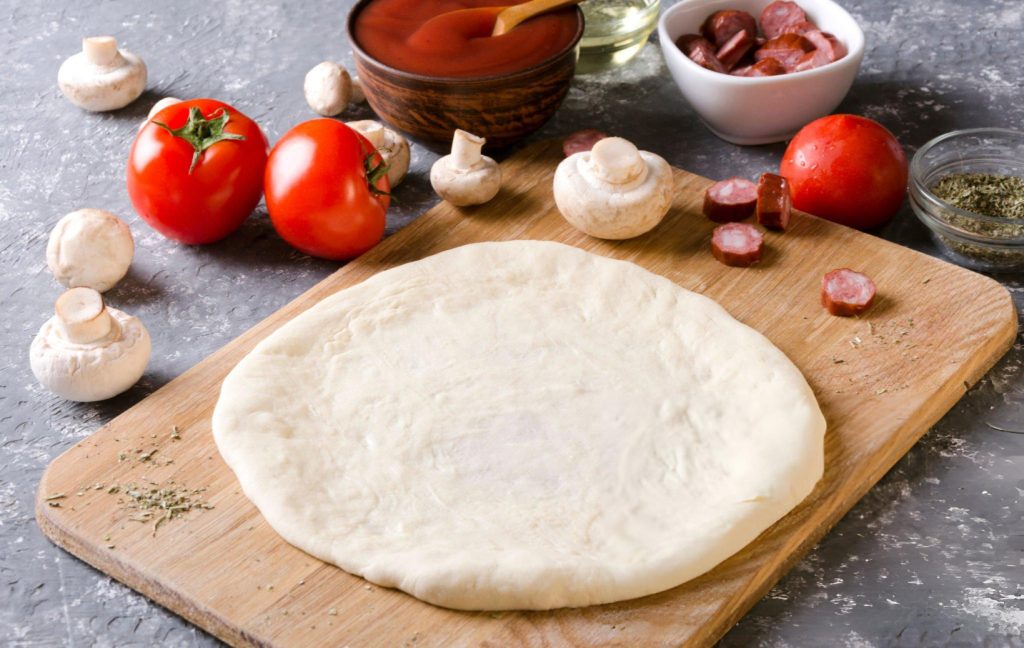
What to Serve With This Recipe
Your freshly baked pizza deserves the perfect accompaniments. To complement the flavors of your homemade pizza, consider pairing it with a simple arugula salad dressed in a light lemon vinaigrette. The peppery greens provide a refreshing contrast to the rich, cheesy pizza. For a heartier option, roasted vegetables or a caprese salad with fresh mozzarella, tomatoes, and basil can add a burst of flavor that pairs beautifully with the pizza.
If you’re looking to elevate your pizza night, experiment with different toppings. Go beyond the classic tomato sauce and mozzarella—try combinations like prosciutto and arugula, or a white pizza with ricotta, garlic, and spinach. The options are endless, and customizing your toppings can make each pizza unique and catered to your tastes.
Troubleshooting Common Dough Issues
If your dough turns out too sticky or dry, don’t worry—this is a common issue with an easy fix. If the dough is too sticky, slowly add more flour, a tablespoon at a time, until the texture improves. Conversely, if it’s too dry, add a little more water, again in small increments, to bring it back to the right consistency.
In case your dough isn’t rising properly, it could be due to several factors. Ensure that your yeast is fresh and that the water you used wasn’t too hot or too cold. Sometimes, just giving the dough more time in a warm place can make all the difference.
Achieving the right texture is essential for a pizza crust that’s both crispy on the outside and tender on the inside. To get that perfect balance, make sure your oven is fully preheated before baking and consider using a pizza stone if you have one. This helps in distributing the heat evenly, resulting in a more consistent bake.
Enjoy Your Homemade Pizza
Creating your own pizza dough from scratch is a rewarding experience that brings a new level of appreciation for this beloved dish. As you slice into your freshly baked pizza, you’ll taste the difference that comes from using quality ingredients and taking the time to craft the dough yourself. Whether you’re enjoying it with family, friends, or savoring it solo, this homemade pizza is sure to become a staple in your kitchen repertoire. Don’t be afraid to get creative with your toppings and share the joy of pizza-making with others—it’s an experience worth savoring.
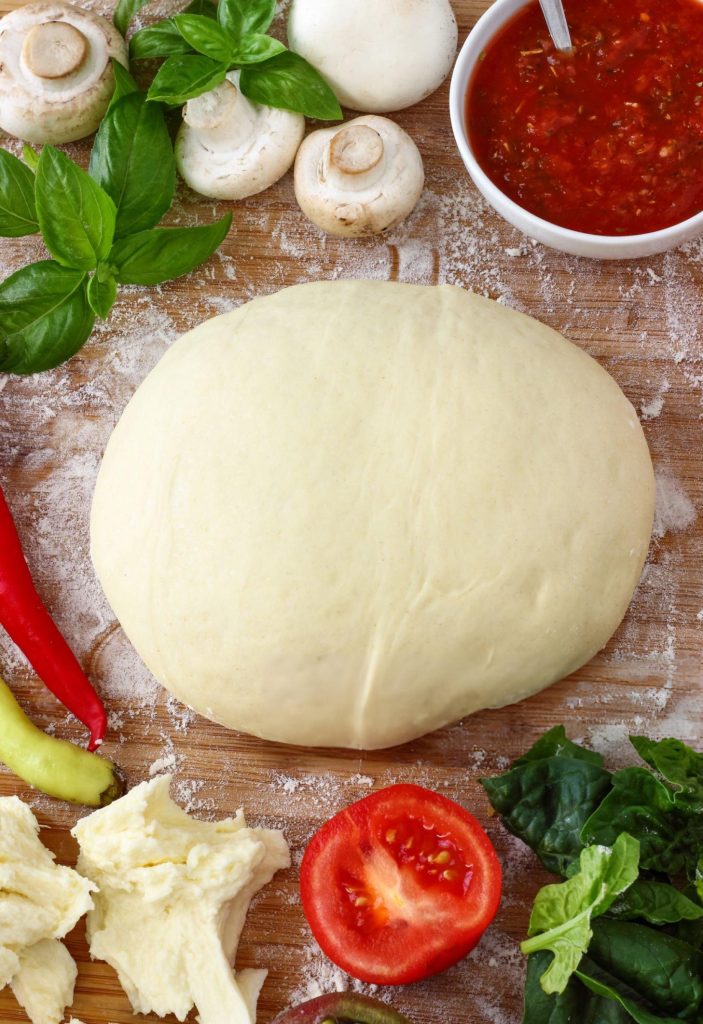
Ingredients
- 1 ½ teaspoons sugar
- ¾ teaspoon salt
- ¾ cup warm water³ (175ml)
- 1 packet instant yeast² (2 ¼ teaspoons)
- 2 Tablespoons olive oil + extra for brushing
- 2-2 ⅓ cups all-purpose flour OR bread flour¹, divided (250-295g)
- ⅛-¼ teaspoon garlic powder and/or dried basil leaves (optional)
Instructions
In a large mixing bowl, combine 1 cup (125g) of flour, instant yeast, sugar, and salt. If you’d like to enhance the flavor, now is the time to add the garlic powder and dried basil.
Pour in the olive oil and warm water, stirring the mixture vigorously with a wooden spoon until fully combined.
Gradually incorporate another 1 cup (125g) of flour into the mixture. Continue to add additional flour as necessary (up to an extra ⅓ cup) until the dough begins to form a cohesive, elastic ball that slightly pulls away from the sides of the bowl. The dough should remain a bit tacky, but manageable with your hands.
Prepare a separate large, clean bowl by drizzling it generously with olive oil, using a pastry brush to ensure the sides are well coated.
Lightly flour your hands, shape the dough into a round ball, and place it into the prepared bowl. Roll the dough along the bowl’s interior to fully coat it with olive oil. Cover the bowl tightly with plastic wrap and set it in a warm spot.
Allow the dough to rise for approximately 30 minutes or until it has doubled in size. If you’re planning to bake the pizza, preheat your oven to 425°F (215°C) now so it’s ready when the dough is.
Once the dough has risen, gently press it down to deflate it, then transfer it to a lightly floured surface. Knead the dough briefly, about 3-5 times, until it becomes smooth.
Using either your hands or a rolling pin, shape the dough into a 12″ circle.
Place the dough on a parchment-lined pizza pan, pinching or folding the edges to form a crust.
Drizzle about a tablespoon of olive oil over the surface of the dough and use a pastry brush to spread it evenly, including the crust.
To prevent the dough from puffing up during baking, use a fork to prick holes across the center.
Add your preferred toppings, then bake in the preheated oven for 13-15 minutes or until the toppings are golden and the crust is crisp. Slice and serve.
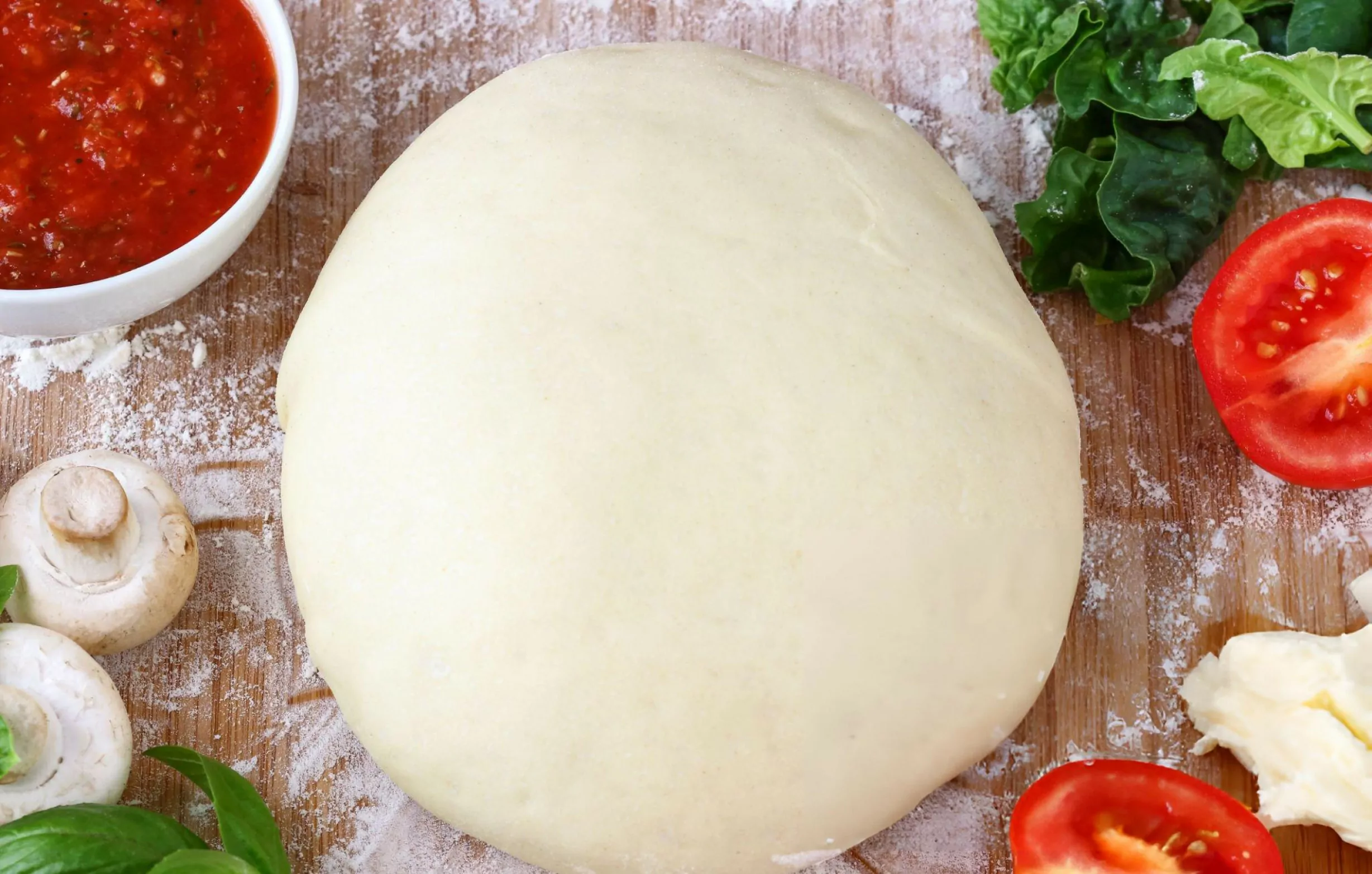
Pizza Dough Recipe
Ingredients
- 1 ½ teaspoons sugar
- ¾ teaspoon salt
- ¾ cup warm water³ 175ml
- 1 packet instant yeast² 2 ¼ teaspoons
- 2 Tablespoons olive oil + extra for brushing
- 2-2 ⅓ cups all-purpose flour OR bread flour¹ divided (250-295g)
- ⅛-¼ teaspoon garlic powder and/or dried basil leaves optional
Instructions
- In a large mixing bowl, combine 1 cup (125g) of flour, instant yeast, sugar, and salt. If you’d like to enhance the flavor, now is the time to add the garlic powder and dried basil.
- Pour in the olive oil and warm water, stirring the mixture vigorously with a wooden spoon until fully combined.
- Gradually incorporate another 1 cup (125g) of flour into the mixture. Continue to add additional flour as necessary (up to an extra ⅓ cup) until the dough begins to form a cohesive, elastic ball that slightly pulls away from the sides of the bowl. The dough should remain a bit tacky, but manageable with your hands.
- Prepare a separate large, clean bowl by drizzling it generously with olive oil, using a pastry brush to ensure the sides are well coated.
- Lightly flour your hands, shape the dough into a round ball, and place it into the prepared bowl. Roll the dough along the bowl’s interior to fully coat it with olive oil. Cover the bowl tightly with plastic wrap and set it in a warm spot.
- Allow the dough to rise for approximately 30 minutes or until it has doubled in size. If you’re planning to bake the pizza, preheat your oven to 425°F (215°C) now so it’s ready when the dough is.
- Once the dough has risen, gently press it down to deflate it, then transfer it to a lightly floured surface. Knead the dough briefly, about 3-5 times, until it becomes smooth.
- Using either your hands or a rolling pin, shape the dough into a 12″ circle.
- Place the dough on a parchment-lined pizza pan, pinching or folding the edges to form a crust.
- Drizzle about a tablespoon of olive oil over the surface of the dough and use a pastry brush to spread it evenly, including the crust.
- To prevent the dough from puffing up during baking, use a fork to prick holes across the center.
- Add your preferred toppings, then bake in the preheated oven for 13-15 minutes or until the toppings are golden and the crust is crisp. Slice and serve.
Notes
- All-purpose flour yields a softer crust, while bread flour gives a slightly crispier exterior. For more details on the differences between all-purpose and bread flour in pizza dough, refer to the post.
- Active dry yeast can be used in place of instant yeast (use the same amount: 2 ¼ teaspoons). It’s recommended to proof the yeast first with the ¾ cup of warm water, although mixing it directly into the dough has also proven successful.
- Water temperature should ideally be between 105-115°F (40-46°C). Warm tap water is sufficient, but ensure it isn’t too hot to avoid killing the yeast.
- Let the dough rise at room temperature as instructed, then deflate it, wrap it tightly to prevent drying out, and store it in the refrigerator for several days or freeze for up to a month.

